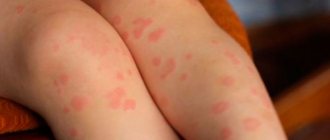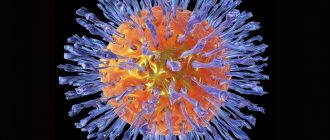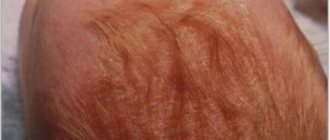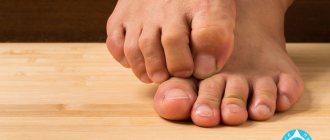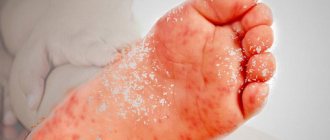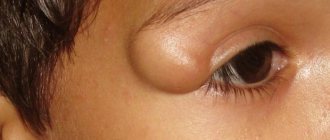Pediatrician
Sayfulina
Maryam Zakareevna
32 years of experience
Pediatrician of the highest category, member of the Union of Pediatricians of Russia
Make an appointment
Miliaria in children under one year of age and older is a fairly common skin lesion, which is a rash caused by severe sweating or poor care of the child’s delicate skin. It is important to understand that the baby’s thermoregulation processes are not yet perfectly established, and therefore the slightest negative factors can cause an undesirable reaction - parents should not be scared and think that this is a rare phenomenon. Almost all kids go through this.
However, you shouldn’t treat this problem negligently either: ordinary heat rash without treatment tends to become more complicated and worse, and in this case, longer and more complex treatment will be required - it’s better not to let it get to that point.
Growth and adaptation of the body
After birth, the newborn must adapt to a new unusual environment.
The work of the upper skin is being improved: epidermis, dermis and sebaceous glands. White or yellowish pimples on the face of a newborn baby that appear at 1 month of life are milia (closed comedones). They look like millet grains and are localized on the forehead, nose, cheeks, and chin. The cause of milia is blockage of immature sebaceous ducts. Usually, by the end of the third month, when the body has adapted and natural physiological processes have improved, these comedones disappear on their own.
White pimples on a baby's face
The appearance of white pimples on the face of a newborn is explained by the beginning of the baby’s adaptation to environmental conditions. Pimples do not pose any danger and do not cause any inconvenience to the child.
White pimples on a baby's face appear immediately after birth; they may appear within a few weeks.
2-3 weeks after birth, pimples appear due to the immaturity of the sebaceous glands of the infant. This effect is called milia. The rashes have the appearance of pearls and appear, as a rule, on the cheeks, under the eyes, on the forehead and on the nose. As the sebaceous ducts develop, the pimples gradually disappear on their own.
Thus, it is obvious that the appearance of pimples on a baby’s face is temporary and does not require any special treatment, and the pimples gradually disappear without leaving any traces.
How to treat a rash
If acne, prickly heat, or acne symptoms appear on the skin of a newborn, you should urgently contact a pediatric dermatologist. Superficial self-medication is excluded, otherwise the manifestations will become even more abundant. After identifying the provoking factor and completely eliminating it, treatment is conservative, and alternative methods of traditional medicine can be additionally used.
All over the body
If a small itchy rash is spread throughout the body, it is possible that it is prickly heat.
To effectively eliminate it, it is important to control the heat exchange of the newborn body, correctly apply the baby to the breast during feeding, and organize bathing in the morning and every evening with the addition of a decoction of chamomile, celandine or string to the water
On the cheeks
This is an eloquent sign of diathesis. Therefore, before removing a rash from a newborn, you need to review your diet and exclude potential allergens from it. The irritant enters the child's body through breast milk, causing trouble for mother and baby. To relieve unpleasant symptoms, the doctor prescribes mild antihistamines or drink a weak chamomile decoction.
On the neck
This may be a manifestation of contact dermatitis when delicate skin comes into contact with synthetic clothing materials
It is important to exclude contact of the non-born with a potential allergen and additionally use Sudocrem ointment. The drug is non-greasy, does not contain alcohol, will relieve inflammation, swelling and redness, without drying the skin, and reduces skin rashes
On the forehead
In such a clinical picture, the injured child is not recommended to wear a hat, but it is recommended to use a weak solution of potassium permanganate externally, and Fenistil drops internally for children from 1 year of age
It is important that the solution does not get into the ear, moisten the cotton wool and thoroughly treat each wound. Treat until the characteristic rash disappears completely
On the stomach
This is a characteristic sign of atopic dermatitis, which is prone to a chronic course without timely treatment. The newborn should be given antihistamines and probiotics, according to the age category and the pediatrician’s recommendations, bathe the baby daily in chamomile and string, and be sure to monitor the nutrition of the nursing mother.
In the crotch
This is a characteristic sign of diaper dermatitis in a newborn. To quickly get rid of the characteristic perineal rash, you must carefully observe the rules of personal hygiene of the baby, examine all folds, use powder and diapers only from hypoallergenic materials, buy Bepanten cream for regular treatment of problem areas.
On hands
When a rash appears on the hands, it is important to rule out a childhood infectious disease. To do this, contact a pediatrician together with the newborn, undergo an examination, and differentiate the diagnosis.
If the appearance of a rash is preceded by a non-infectious process, the phenomenon is temporary and goes away on its own after the allergen is eliminated from the body. Otherwise, it is recommended to be treated with medication, sometimes with the use of antibiotics.
Around eyes
It is possible that this is the result of using wet wipes that contain fragrances and alcohol. It is necessary to immediately abandon such caring cosmetics, otherwise the characteristic rash will soon become a common occurrence for the newborn. To eliminate allergy symptoms, you can use unsteeped tea as a lotion or chamomile infusion orally
Allergic rash in a newborn
The cause of such rashes is exposure to a provoking factor, which may be a food allergen, household chemicals, or skin care cosmetics. In addition, external irritants cannot be excluded from household, natural, or chemical origin. In all cases, the rash in infants looks the same and causes itching, burning, internal discomfort, and emotional instability. This unpleasant symptom characterizes several diseases presented below, so differential diagnosis is required. So:
- Food allergies. More often it appears on children's cheeks due to the penetration of the allergen into the digestive tract. The infection can enter the newborn's body through the mother's breast milk.
- Contact allergies, also called household allergies. Appears when the skin comes into direct contact with external allergens - potentially hazardous substances. The smell of paint or animal hair can provoke such an allergic reaction in a newborn.
- Drug allergy. A red rash becomes a side effect of long-term conservative treatment for a newborn and not only. Due to the weakening of the immune system by the disease, the newborn body is not able to resist partial intoxication of the body from the pills.
- Hives. This is a complicated form of an allergic reaction, in which the red rash is small and profuse. Prone to forming blisters. Externally, the rash resembles a nettle burn, hence the name. A complication for a newborn patient is anaphylactic shock, Quincke's edema.
- Prickly heat. The rash in a baby appears in the folds of the skin due to impaired sweating of these areas. The foci of pathology are the groin, back, armpits, and neck. The main task of parents is to restore the newborn’s heat exchange, dress the baby according to the weather, and remove the rash.
- Diaper dermatitis. Occurs upon contact with wet diapers, since liquid feces and urine irritate sensitive skin. First, irritation appears, and then diaper rash and sores appear. Parents need to follow the rules of personal hygiene for their newborn baby.
- Atopic dermatitis. A common skin disease that causes a blistering rash in a newborn. The foci of pathology are the cheeks and chin, legs and arms, and children’s buttocks. The rash itches and makes the newborn nervous and irritable.
Help a child
Prickly heat
The main remedy is to ensure a comfortable temperature in the room and proper hygienic care of the newborn’s skin. The baby should not be wrapped or overheated; daily air baths should be provided and the skin should be allowed to breathe without clothing or diapers.
When pimples appear, you can use special antibacterial ointments for babies (Bepanten, Desitin), powders, talc, which dry out the skin and eliminate diaper rash.
It is recommended to bathe in water with the addition of decoctions of herbs that have an antiseptic effect: chamomile, celandine, string, St. John's wort. If, after using the above remedies, prickly heat does not go away, you should consult a dermatologist, since a complication with the addition of a bacterial infection is possible. In this case, the doctor may prescribe antibacterial, immunomodulatory and antihistamine medications.
Allergic rashes
If you have allergic skin reactions, you should choose care products more carefully. It is recommended to wash laundry with laundry soap or special detergents for washing children's clothes. Cosmetics should be natural and hypoallergenic, clothing and bedding should be made from natural, breathable fabrics.
Pustules
It is necessary to constantly monitor the condition of the baby’s skin and, in case of the slightest damage or accidental scratches, treat them with antiseptic agents, constantly iron the clothes, and regularly wash the toys under hot boiled water.
Psoriasis
Due to the fact that this disease has not been fully studied, it is impossible to completely cure it. However, proper care and therapy can alleviate the condition and cope with painful symptoms in the acute period. First of all, the doctor prescribes medications that moisturize the affected areas of the skin (Vaseline, Hydrocortisone, Flucinar ointments). At the same time, immunostrengthening agents are prescribed (complex vitamins, which include vitamins A, C, B, PP), and physical therapy is also carried out.
How to treat diaper rash on a baby's neck?
If diaper rash occurs in a child, it is important to begin treatment as soon as possible. Following the rules of hygiene and caring for your baby’s skin will help you quickly cope with diaper rash and prevent the development of complications.
To relieve the first symptoms of skin diaper rash, instead of the usual baby cream, it is necessary to use products with such active substances as: panthenol, benzalkonium, cetrimide.
If, in addition to redness, the baby already has pimples, pustules and microcracks, then in addition to the above measures, it is recommended to treat the skin with drying agents based on zinc and talc, and you can also use methyluracil, tannin and other ointments.
Diaper rash with cracks and erosions is the most difficult to treat. For such manifestations of skin diaper rash, lotions with various solutions are used (for example: tannin, silver nitrate).
After eliminating weeping, it is recommended to apply zinc-containing preparations, as well as antibacterial ointments.
If a secondary infection is clearly attached, topical antibiotic-based drugs are prescribed (in the case of a bacterial infection), and external antifungal drugs (in the case of a fungal infection).
In any case, either a pediatrician or a dermatologist makes a diagnosis and prescribes treatment, so if any rashes appear on your baby’s skin, you should consult a specialist!
Self-medication can lead to unpleasant consequences, but a correct diagnosis in time will save the mother’s nerve cells and the baby’s health!
Prevention
Daily air baths will prevent the baby from many skin problems.
Parents should follow preventive measures to prevent the formation of rashes:
- A mother who is breastfeeding should carefully monitor her diet and avoid any allergenic foods.
- When feeding formula, you need to carefully choose the appropriate composition.
- The newborn should be bathed daily with special products. It is better to wash his clothes with special powders and rinses for children, then be sure to iron them.
- You need to take your child for walks often.
- When changing clothes, you need to let the newborn lie down for a while without clothes so that the skin can breathe.
- The children's room should not be hot.
Prevention of the appearance of rashes in newborns and children under one year old lies in reasonable and competent hygiene, in proper care of delicate baby skin. There are several simple rules that will help protect your baby’s skin from possible troubles and diseases:
- Bathe your newborn every day. However, you should only use baby soap once every 3-4 days. Baby up to one year old can use soap to wash their hair once a week. This will prevent the skin from drying out.
- Do not rub your baby with a towel. After water procedures, lightly blot the damp skin; a sufficient amount of liquid should remain in it.
- Be sure to wipe your child's skin with wet wipes after massage with oils. A large amount of fat makes it difficult for the skin to “breathe”.
- Give your child naked air baths every day.
- You should not use ointments and creams, as well as cosmetics that are not intended for use at an early age, even if they perfectly help adults and older children.
- Maintain optimal temperature and humidity in the room where the baby lives.
- Do not clean your home with household chemicals that contain chlorine.
- To have healthy skin, a child must eat properly. Any mother’s experiments with complementary feeding can result in the appearance of a rash.
- The child needs to be vaccinated against dangerous infections on time. The timing of vaccinations is indicated in the National Vaccination Calendar; there is no need to violate them.
- Treatment is prescribed by a doctor. Allergic, infectious and parasitic rashes cannot and should not be treated with folk remedies. This is a rule that parents should remember like a multiplication table.
- When caring for problem skin, you should adhere to the “golden” standard of dermatology - everything that is wet should be dried, and everything that is too dry should be moisturized. Therefore, for eczema and diaper rash, drying ointments and powders are used, and for dry skin, baby cream and other moisturizing creams are used. If this rule is not followed, it is unlikely that you will be able to keep your baby’s skin healthy.
- The protective properties of children's skin can be increased by strengthening the baby's general and local immunity. For general protection, walks in the fresh air, exercise, and proper nutrition are important. Local immunity will benefit from contrast douches and hardening, which can be done almost from the very birth of the child, as well as massage and air baths.
- Do not neglect protective equipment, especially if you plan to keep your baby in the sun. UV protection creams and sprays can be used on all children over six months of age.
Causes
The main cause of heat rash in a child is overheating, and it is caused by various factors, including:
- Too warm, and synthetic clothes at that.
- Untimely changing of diapers, especially in hot weather or in a warm room.
- A minimal amount of air baths and infrequent bathing, due to which the skin is not cleansed and does not breathe.
- Using cosmetics that are too oily and thick on the skin, which does not allow heat to be released properly.
- Diseases associated with fever. Especially if parents also use warming treatment methods.
To overheating we will add such factors as allergies to various materials, friction and pressure of clothing, effect on irritated areas of feces and urine.
It may seem that the causes of heat rash in children are due solely to parental care errors, but this is absolutely not the case. There are children who themselves are prone to developing this condition. These are allergy sufferers, overweight children, children with various endocrine diseases (for example, diabetes). Also at risk are formula-fed children and premature newborns. When caring for such babies, you should be especially attentive to the condition of the skin and body.
Location of the rash
You can determine why a child has spots on his body by their location.
On the face
Causes:
- sudden change in temperature;
- genetic disorders;
- infectious diseases;
- allergy;
- disturbances in the functioning of the stomach and intestines.
Very often, a rash appears on the neck and around the mouth in infants due to diathesis. Moreover, both breastfed and bottle-fed children are susceptible to the disease. Having received a share of the allergen, the body reacts with red rashes around the mouth and neck. To get rid of them, the child must follow a diet for some time.
On the body
- If the spots on the stomach and back, on the chest are light in color and do not merge together, this means that they are caused by a contact allergy. Maybe it's laundry detergent or other detergents. Try to eliminate the cause and see if the spots on your stomach and back disappear.
- If the spots on the stomach and neck were initially white, then turned red and merged together, this is already a reason for panic. This sign is evidence of intoxication of the body. The baby must be urgently hospitalized to remove the allergen.
On the stomach
Minor rashes in the abdominal area sometimes indicate serious illnesses. Only a qualified doctor can determine the true cause of their occurrence.
Possible ailments:
- prickly heat;
- staphylococcus;
- blood diseases;
- rubella;
- lichen;
- dermatitis;
- scarlet fever.
If you notice symptoms in the form of a rash, you should consult a doctor to diagnose the disease in the infant.
On the butt
What can help if you notice a rash in the groin and butt? This:
- drying ointments;
- constant change of diapers, panties and bed linen;
- air baths;
- bathing with herbs (if there are no allergies).
If you follow these simple rules, the rash on your butt will go away very quickly. The most important thing is to never forget about them.
The best prevention for any rash is hygiene. If you do not want to further treat your child for allergies after a massage, for spots on the butt, on the chin and around the mouth, on the chest, just bathe your baby more often and always monitor the composition of the products and food products used.
The cause of the rash can be indicated by its location. With contact dermatitis, the rash usually appears where the skin has touched the irritant. With scarlet fever, the neck, chest and back are first covered, then it spreads to the whole body. A localized rash may indicate an insect bite.
If it is clear that the baby’s rashes appear in the head area and then smoothly spread throughout the body, this may indicate the presence of an infection. A small rash on the forehead of a child up to a month old may indicate a hormonal rash, there is nothing wrong with that.
You should not treat a child yourself, relying solely on the localization of tumors. A rash on the chest of a baby can often be associated with clothing made of wool or synthetic materials. With measles, chickenpox, scarlet fever, it can cover the entire body, including the legs.
Important! Examining what the rash looks like is only the initial diagnosis. It is necessary to carry out a number of examinations to establish the exact cause
Only a doctor can do this.
Symptoms
Symptoms of prickly heat in children include:
- The appearance of a characteristic rash on the neck, in the ear area, on the back of the head, along the hairline, armpits, in the upper chest, as well as on the back, in the groin folds and on the buttocks.
- Small rashes in the form of bubbles with transparent contents. In more complex cases, these are reddish nodules with an inflamed rim. The rash reacts to temperature, so it can decrease or increase depending on the environment.
- Weeping lesions - they occur when there is extensive damage to the skin.
- Pustules, swelling, redness of the skin and a putrid odor. This is not so much a symptom of prickly heat in children, but a signal that a bacterial or fungal infection has joined it.
- Soreness, itching and other unpleasant sensations that cause anxiety in the child make him capricious. This is not observed with ordinary heat rash, but if the condition is complicated, such negative factors will progress, simultaneously causing an increase in body temperature.
At any stage of heat rash in a child, even if it is very mild, it is necessary to consult a pediatrician. If complications arise, you should immediately consult a doctor - such issues are dealt with either by a pediatrician or a pediatric dermatologist.
What parents should do when pimples appear
Red spots on the face of a newborn baby
Important! If your child has acne, you need to make sure that the baby does not overheat. This is a must to keep your skin in good condition.
When a baby is too warm, skin changes worsen.
The ambient temperature must be maintained at 20-22ºC. The skin on the back of the baby's head should be warm and dry. The bath must be taken at a temperature no higher than 37ºC.
What can you do
If your baby has pimples with white heads on his face or body, you can:
- When bathing, use potassium permanganate in low concentration;
- Care for your baby’s facial skin every day by wiping it with a cotton pad moistened with boiled water;
Washing a newborn
- A decoction of the string has a good effect on the skin. It is added to the bathtub for bathing the baby or, during hygienic procedures, it is treated with cotton wool dipped in a herbal decoction on areas where redness and pimples appear.
What should you be wary of?
White pimples in a newborn usually do not require a visit to the doctor. However, you should contact your pediatrician or pediatric dermatologist if:
- The child has purulent rashes. The doctor may start treating them with antibiotic ointment. Its use is necessary due to the risk of generalization of infection;
- Despite proper hygienic care, acne does not go away and even increases;
Rash growth
- Acne lesions appear in unusual places: they are not observed on the face, but only in the armpit, in the crooks of the arms, groin, and on the neck.
Important! The doctor may recommend a zinc suspension (Tsindol), which has an anti-inflammatory and slightly drying effect, to smear on the pimples. When purulent pimples form and spread, if timely measures are not taken, the following complications may arise:
When purulent pimples form and spread, if timely measures are not taken, the following complications may arise:
- streptoderma - a bacterial infection, especially often occurring in the diaper area and skin folds;
- furunculosis.
What is prohibited to do
Milia in a newborn appear as a result of clogged skin pores. These are stagnant epidermal cysts resulting from the accumulation of sebaceous masses. Such formations are not treated, are not lubricated, and it is strictly forbidden to squeeze them, because this can lead to infection and abscess. After a few days or weeks, milia go away on their own.
Cannot be used to treat pimples:
- strong solution of potassium permanganate;
- brilliant green;
- products containing alcohol;
- Fukortsin;
- fatty and hormonal ointments.
It is also not recommended to pour baby powder directly onto your child's pimples.
Important! You cannot independently prescribe antihistamines, antibiotics, or sorbents to your baby. Emollients used to wash the baby (baby emulsions, gels and bath liquids) can be used for baby hygiene
They do not cause dry skin, do not disturb its delicate protective barrier, even strengthen it and accelerate healing
Emollients used to wash the baby (baby emulsions, gels and bath liquids) can be used for baby hygiene. They do not cause dry skin, do not disturb its delicate protective barrier, and even strengthen it and accelerate healing.
Rashes in a newborn baby
As a rule, in the first weeks of their child’s life, parents encounter the following types of rashes on their child’s skin:
- Acne of newborns. These are inconspicuous white pimples, the appearance of which is physiological in nature. According to statistics, a third of children experience such rashes in the first weeks and months after birth. As a rule, white pimples that appear on the face, scalp and neck of a newborn do not require any special treatment or medication. Since they do not have a comedon - a clogged pore, under normal conditions they practically do not become inflamed and do not fester.
note
According to experts, the cause of this kind of acne is an excess of maternal hormones in the baby’s body. As soon as the child’s hormonal levels return to normal (on average 1-3 months), the acne will disappear on its own. During the period of hormonal rashes, parents are required to do only one thing - keep the baby’s skin dry and clean.
- Acne covering large areas of the skin. This type of rash can be identified by the red base and white tip of the pimples. Whitish-yellow pus accumulates under the skin. As a rule, acne appears a week after birth and can remain on the skin for almost a month. This problem arises due to the active functioning of the glands. If the rashes do not cause discomfort to the baby (they do not itch or itch), and no inflammatory processes are observed, then parents do not need to worry about them, everything will go away and not a single trace will remain.
- Milia is another type of rash that is quite common in newborn babies. As a result of the accumulation of secretions in the sebaceous glands, or in other words, blockage of the sebaceous ducts, small white dots appear on the baby’s face, which eventually disappear on their own without any treatment. These pimples should not be squeezed or picked off, as this can cause infection and thereby provoke an inflammatory process.
All of the above types of rashes are typical only for newborn babies; they are not contagious and, subject to certain hygiene rules, go away on their own without drug treatment.
Newborn acne
Neonatal acne can appear in the first weeks of a baby's life on the forehead, nose and cheeks. In appearance, they resemble pimples with purulent heads, characteristic of teenage rashes. It is assumed that the cause of acne is increased production of sebum , which clogs the ducts of the sebaceous glands and provokes an inflammatory reaction. The pathogenesis of the appearance of small pimples in newborns is also associated with the formation of the hormonal system. The body gets rid of the transplacental influence of maternal androgens [2], and adrenal hormones begin to be produced more intensively, which affect the condition of the skin. Newborn acne does not require treatment [9] - standard daily care using delicate soap or baby cosmetics is sufficient. In most cases, pimples that appear on the face go away on their own by the age of 4 months.
Non-infectious rashes
Herpes types 1 and 2
- Nature of the rash: individual watery pimples or grouped rash. At the beginning of the disease they are filled with clear liquid, after 1-2 days they are filled with pus. They open spontaneously, and in their place long-term non-healing wounds and crusts form. Pimples are painful and itchy.
- Location: most often in the mouth, genitals and lips, but can affect other areas.
- Additional symptoms: fever, headache, inflammation of the lymph nodes, general malaise.
- Treatment: antiviral drugs, antihistamines and antipyretics.
Shingles
- The nature of the rash: a group of bubbles with transparent contents, which become cloudy on the 3-4th day. Accompanied by severe burning and pain in the affected areas. Crusts form within 2-3 weeks.
- Localization: nerve nodes on the face and head, back, back of the head, shoulders, neck, arms and legs.
- Additional symptoms: headache, temperature up to 39 degrees, disruption of the gastrointestinal tract, inflammation of the lymph nodes, weakness.
- Treatment: antiviral drugs, antihistamines and antipyretics.
Chicken pox
- Character of the rash: small blisters filled with light liquid. They itch a lot. They burst quickly and a small wound appears in their place.
- Localization: throughout the body.
- Additional symptoms: fever, rarely – cough.
- Treatment: the blisters are treated with an antiseptic and antiallergic medications are prescribed.
Streptoderma
- Nature of the rash: purulent spots or blisters up to 10 centimeters. The rash causes burning and itching.
- Localization: first on the face, then spread throughout the body.
- Additional symptoms: intoxication of the body, temperature up to 38-39 degrees, lymphadenitis.
- Treatment: antibacterial ointments, antibiotics, antipyretic drugs, hypoallergenic diet, treatment of the rash with brilliant green, boric alcohol.
Enterovirus
- Nature of the rash: blistering rash with clear liquid.
- Localization: on different parts of the body and mucous membranes.
- Additional symptoms: headache, nausea, vomiting, fever.
- Treatment: immunomodulators, antibiotics, drugs aimed at eliminating symptoms.
Pemphigus
- Character of the rash: transparent watery blisters with a red rim.
- Localization: at the beginning of the disease - in the oral cavity, then - arms, legs, abdomen.
- Additional symptoms: weakness, elevated body temperature.
- Treatment: antiviral drugs, glucocorticosteroids, antihistamines, antipyretic drugs.
Felinosis
- Character of the rash: blisters with a small crust. Appear at the site of infection.
- Localization: at the site of cat scratches.
- Additional symptoms: inflammation of the lymph nodes, intoxication of the body.
- Treatment: anti-inflammatory and antibacterial agents, antiallergic drugs.
Watery pimples can be caused by parasite infestation. The blistering rash on the stomach, feet and between the fingers and toes is caused by the scabies mite. The rash is very itchy, especially at night. The blisters turn into pink spots a few days after they appear. The disease is treated with external agents (for example, benzyl benzoate ointment) and antihistamines.
Foot fungus can appear as small, watery blisters on the feet and heels. A fungal infection can enter the body when visiting public swimming pools or the gym. It is often accompanied by itching and flaking of the skin. An infection on the leg is treated with antifungal ointments and gels, and sometimes tablets are used.
- Small watery pimples in newborns and infants are caused by prickly heat. It occurs as a result of overheating and improper care of the baby's skin. At older ages, this phenomenon occurs less frequently. Miliaria is eliminated with the help of drying agents (decoctions of medicinal plants, powders, ointments).
- Allergic blistering rash is accompanied by swelling, itching, redness and peeling of the skin. The disease can be caused by food, household chemicals, cosmetics and medications. A distinctive feature of an allergic rash is that it disappears after the cause of the rash is eliminated. Allergies are treated with antihistamines.
Seborrheic dermatitis
Not only red pimples, but also yellowish scales may appear on the skin of a newborn. These are signs of seborrheic dermatitis, a disease associated with increased secretion of sebum. Scales form in the first month of life on areas of the body with a large accumulation of sebaceous glands - on the scalp, upper third of the back, face, chest and in the ear area. Seborrheic dermatitis is sometimes called “milky crusts”, which may be associated with the use of inappropriate cosmetics for the care of infant skin. In fact, the disease is caused by high levels of maternal hormones in the blood or changes in the biochemical composition of lipids on the surface of the skin [4].
In most cases, childhood seborrheic dermatitis goes away on its own. Parents just to take care of proper care , but it is not recommended to diligently remove the crusts - you risk damaging the delicate skin and causing infection. It is better to use specially developed products - such as Foam Shampoo for “milk crusts” for newborns. It facilitates the removal of scales in 90% of cases , and in 95% of babies it soothes the scalp [5.2]. The product contains 99% ingredients of natural origin. The shampoo is fragrance-free and has a “tear-free” formula. If you have thick, dense scales, which are located not only on the scalp, but also in other areas, a “milk crust” cream , which helps to completely remove “milk crusts” in an average of 7 days [5.3].


